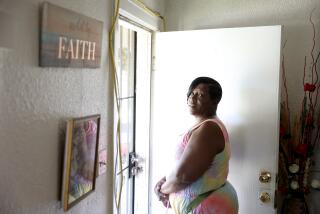As the Need Grows, Foster Homes Dwindle
The frightened 3-year-old brought to Barbara Williams’ door late one night presented a special challenge for the 20-year foster mother.
The trembling child, who had just been separated from his parents, spoke only Spanish.
“I would have to act out things so he could understand,” Williams said. “Later, I gave him picture books with English words, and sure enough, he started picking it up. But it was very hard for him.”
Social workers had little choice but to place the child with Williams in Oxnard because there are so few foster homes in Ventura County operated by adults of Latino descent. Even fewer foster parents speak Spanish.
It’s a problem that the county’s Human Services Agency is tackling head on with a new campaign aimed at increasing the number of Latino-operated foster homes. Nearly 52% of the 885 children in foster care are of Latino descent, but only 8% of foster homes contain Latino adults, said Trish Cavanaugh, director of foster services for the Human Services Agency.
“Certain foster families work best with certain foster kids,” Cavanaugh said. “But sometimes you have a kid and you just have to put them wherever a bed is available.”
In addition to the cultural gap, social workers are struggling with a long-term trend of fewer foster homes even as more children are being taken into protective custody due to suspected abuse or neglect.
In 1991, Ventura County had 341 foster homes. Today, there are 166. Although the Human Services Agency is starting to see an increase, the numbers are still far below what is needed to make the best placements for children, Cavanaugh said.
Motivation Goes Beyond the Pay
Officials give a number of reasons for the decline in foster homes. Women, who make up the majority of foster parents, are entering the work force in growing numbers and are getting better-paying jobs, they say. Other potential foster parents are scared off by the challenge of serving as surrogate parent for a traumatized child who may have significant emotional problems.
Foster parents receive $425 to $597 per month for each child, depending on the child’s age. An additional $50 is paid if a youngster has physical or emotional problems that require more care.
For many, the money is not enough for the effort required, Williams said.
“I think at some point the county needs to recognize that they just have to pay more,” the foster mother said. “It shouldn’t matter, but it does .... It’s very expensive to do this.”
Because the pay is modest, the people who become foster parents tend to be motivated by other things.
Barbara Jacobs, a 13-year foster mother, fits that description. The Port Hueneme woman has cared for 50 children who needed temporary shelter. Along the way, she adopted five children, all siblings.
She is in the process of adopting the sixth, the 2-year-old sister of the others. She and her husband, Richard, continue to take in other foster children as well.
“Yes, fostering is a hard job. But any job is hard,” Jacobs said, pausing briefly as she busily prepared dinner for the hungry brood. “The end result of this is little ones who love you and can call you Mommy.”
County officials have tried various recruiting efforts over the years, which have largely failed. But Cavanaugh believes the newest campaign will succeed because the county is approaching the challenge in a more focused way.
Officials have set recruitment goals for each of the 10 cities in Ventura County, based on need. Oxnard, for example, places about 109 children into protective custody each year and has 60 available foster homes. So the goal for that city is 49 new homes, Cavanaugh said.
Almost all the county’s cities need to increase the number of homes, she said. The exceptions are Simi Valley and Ojai, which already have a sufficient supply.
The first place officials are targeting is the tiny farm town of Santa Paula. About 16 children there become wards of the court each year, but the city has only one foster home.
Judge Charles Campbell, who presides over the Juvenile Court, recalls once being forced to place a young Santa Paula boy with a family in Moorpark because that was the closest bed available.
“It was almost impossible for the parent to visit the child because they had to rely on public transportation, and buses don’t run over Grimes Canyon,” Campbell said. “There should be a place to put these children in the same area or neighborhood where they live.”
When there is a cultural gap, the problems intensify, the judge said. Many children are bilingual until they are placed in foster care. After living with an English-speaking family for several months, many youngsters lose their ability to speak Spanish, he said.
Campbell has joined Supervisor Kathy Long and others in the push to find more homes. He and Long met last week with a group of Santa Paula activists to spread the word.
County Takes Steps to Recruit Parents
The county also is hiring a bilingual recruiter and an ombudsman who will focus on increasing the number of Latino foster homes. Ads are running on Spanish-language radio stations and brochures have been printed in both English and Spanish, Cavanaugh said.
The idea is to treat foster recruitment like a business, she said.
“Basically, we’ve been trying to Band-Aid and patch the system,” she said. “But this is a marketing and public relations problem, which is a full-time job.”
Williams figures she has cared for more than 200 children over the years. As an African American, she focuses on caring for black children, although she does not turn anyone away.
There are certain things black children need that other families might not understand, such as certain foods or hair- and skin-care items, she said.
She recalls the four teenage girls she took to a beauty shop, at great expense, to get Jeri curls, a popular style for many black women.
“They wanted to look like everyone else. They need that,” Williams said. “They need the same clothes, the same hair, the same style, so people don’t look at them and say, ‘Oh, those are the foster kids.’”
More to Read
Sign up for Essential California
The most important California stories and recommendations in your inbox every morning.
You may occasionally receive promotional content from the Los Angeles Times.











